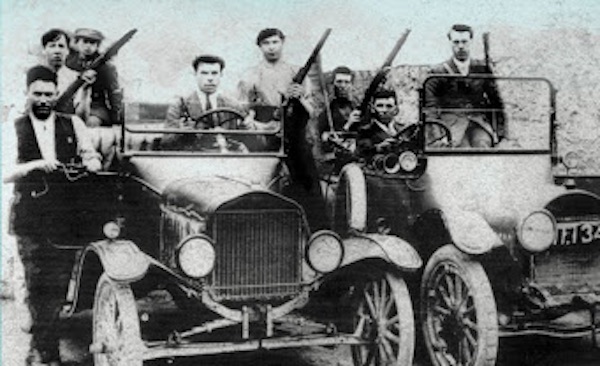
A further extract from the Irish War of Independence and the IRA, 1916-1921, by Colm McInerney.
“We wanted full-time soldiers who were prepared to fight by day or night, ready for any adventure. They would constitute a mobile force capable of striking at a given moment in one district and on the next day springing a surprise thirty miles away… At long last we convinced the Headquarters-staff of the desirability of such a scheme. The flying columns were organised and they bore the brunt of the war during the next twelve months.” - Dan Breen
The first flying columns spread spontaneously in active areas during the summer of 1920. They consisted of the Volunteers who had been forced to go on the run due to their prominence in barracks and other attacks. Some of them had grouped together and engaged in joint operations. However, some men on the run simply hung around all day, wasting resources and irritating the locals. At a meeting of the leadership of the Volunteers in June 1920 this problem was discussed and the idea of a Flying Column was developed:
“Dick Mulcahy was not too keen on the idea, but Michael Collins was very keen on it: ‘We’ll have to get these bloody fellows doing something,’ said Collins referring to the men on the run. (At that time and for some time later, they were a bloody nuisance, for they lounged around, slept late, ate peoples food and did now work for the Company or Battalion in which they happened to be.)”
The provincial flying column generally consisted of a small band of full-time fighting men. A training camp would prepare the men, whose number could range from a dozen to over a hundred in Tipperary and Cork. Most of the columns’ time was spent roaming around evading the police. The local people provided the columns with supplies and entertainment in the form of music and dance. Some areas were more hospitable than others, making the column members feel at home. The columns’ inclination to stay in only a few safe areas was a heavy burden on the locals. The presence of the column in their neighbourhood implicated them in its actions, which meant risking the wrath of the Crown Forces. To protect the columns from approaching enemies, warning systems using flags, fires and empty bottles were successfully used, particularly in Tipperary. Tom Barry describes the core ambition of Flying Columns set up in West Cork-
Strange as it may seem, it was accepted in West Cork that the paramount objective of any Flying Column, in the circumstances then prevailing, should be, not to fight, but to continue to exist. The very existence of such a column of armed men, even if it never struck a blow, was a continuous challenge to the enemy and forced him to maintain large garrisons to meet the threatened onslaught on his military forces, and for the security of his civil administration. Such a Column moving around must seriously affect the morale of garrisons, for one day it would surely strike…
Involvement in the fighting deeply affected the members of the columns and its equivalent in Dublin, the ASU (Active Service Unit). After killing some British intelligence-officers one of the future members of the Dublin ASU was greatly affected:
“Charlie Dalton was very nervous. We went into the Capitol [a church] to ease his mind. […] Charlie Dalton couldn’t sleep that night of Bloody Sunday. He thought he could hear the gurgling of the Officer’s blood and he kept awake in fright until we told him a tap was running somewhere.”
A problem that extended to Volunteers in all areas was the lack of arms and ammunition. After the Flying Columns had started, bringing with them the constant likelihood of open conflict, the lack of ammunition became particularly acute. If a column was under-armed and forced to engage with British troops in the open it would be sluaghtered. Shortages led to disputes over arms. Another serious consequence of the lack of arms was an almost complete absence of firing experience among the men involved in operations. This inexerience led to several fatal accidents and also the failure of several ambushes.
The arms that could be bought from GHQ were totally insufficient to equip all willing men. Arms could not be bought openly, as many restrictions had been put on the sale, importation and ownership s of weapons since the beginning of the Great War. To supplement the shortages, weaponry was bought or forced from soldiers and policemen throughout the struggle. British soldiers who were stationed in Ireland for a short period were often willing to sell equipment to supplement their pay. Another major source of arms and ammunition was found abroad. GHQ as well as some county units sent men to England and even to Germany to obtain weaponry.
Despite all these efforts, there was always insufficient material to provide all IRA units. Supply of ammunition was so short that many units manufactured it themselves. Most country units made buckshot to fill shotgun cartridges. In Dublin, large .303 rifles ammunition was cut down to fit into revolvers:
“We were using .303 stuff, which had been cut down but it was not serviceable. It had split in Jimmy Maginnis’s revolver in his hand.”
Another tedious job was the reloading of faulty ammunition that was bought from British military. After the authorities discovered that the IRA bought ammunition they tried to sell them exploding ammunition that damaged the gun when fired. When the IRA found a distinguishing mark they took the explosives out of the ammunition and replaced it with gunpowder.
![[Irish Republican News]](https://republican-news.org/graphics/title_gifs/rn.gif)
![[Irish Republican News]](https://republican-news.org/graphics/title_gifs/harp.gif)

